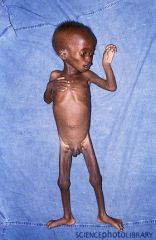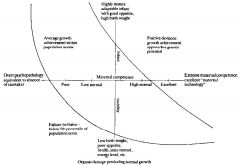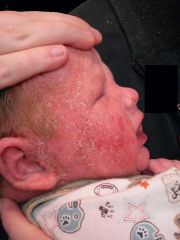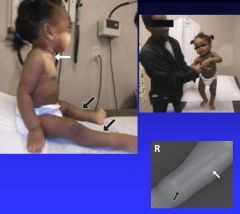![]()
![]()
![]()
Use LEFT and RIGHT arrow keys to navigate between flashcards;
Use UP and DOWN arrow keys to flip the card;
H to show hint;
A reads text to speech;
23 Cards in this Set
- Front
- Back
|
Failure to Thrive
|
= inadequate physical growth
implies nutritional inadequacy of supply and/or utilisation Symmetrical or Disproportionate Organic / Nonorganic /Mixed (physical/psychosocial/mixed) „absolute‟ or „relative‟ definitions |
|

|
head growth is at the expense of all the other area
|
|
|
Definitions of FTT - Relative
|
Rate of growth („relative‟)
Fall off from previously established growth curve Downward crossing of 2 major centile lines on growth chart |
|
|
Definitions of FTT - Absolute
|
Attained growth („absolute‟)
Weight <3rd percentile Weight for Height <5th percentile Weight is 20% or more below ideal weight for height (wasting) |
|
|
Characteristic patterns of growth disturbance
|

|
|
|
Five basic mechanisms of FTT
|
Inadequate intake
Decreased absorption Excessive losses Abnormal utilisation Increased need |
|
|
Mother-Child Dyad
|

The physical and psychosocial health of the mother necessarily determines the health of the foetus/infant/child
And, the converse is also true FTT must affect the mother-child interaction (and may be the result of primary disturbances in this interaction) |
|
|
Psychosocial factors are common in FTT
|
Mother may be preoccupied with inner problems, depressed
Mother may be involved in external demands or the care of others Drug and alcohol abuse Physical absence of the father, domestic violence Poverty Lack of parenting support Parental intellectual disability |
|
|
1) Inadequate intake
|
careful dietary history, observe feeding if possible
Breast feeding problems Errors in formula reconstitution Parental misconceptions about diet and feeding practices Psychosocial problems eg poverty Oromotor or other feeding dysfunction eg cleft palate, poor suck or swallow Medical problems that result in anorexia or food refusal |
|
|
2) Decreased absorption
|
Small intestine- eg Coeliac disease, Cow‟s Milk Protein Intolerance, Crohn‟s disease
Colonic disease- eg Entamoeba histolytica, short segment Hirschsprung‟s Pancreatic disease-eg Cystic Fibrosis, Liver disease- eg chronic cholestatic disorders |
|
|
3) Excessive losses
|
Persistent vomiting
Gastroesophageal reflux disease Gastrointestinal obstruction Metabolic problems Increased intracranial pressure Diarrhoea Inflammatory bowel disease Infection Immunodeficiency Coeliac disease, Cystic Fibrosis Renal losses Diabetes, Renal tubular acidosis, nephrotic s. |
|
|
4) Abnormal utilisation
|
Endocrine problems eg diabetes, hypopituitarism
Inborn errors of metabolism eg mitochondrial disorders Chromosomal abnormality, prenatal insult |
|
|
5) Increased need
|
increased caloric requirements
Congenital heart disease Chronic respiratory disease Neoplasm Hyperthyroidism Chronic or recurrent infection – consider immunodeficiency |
|
|
Evaluation of FTT
|
Growth data
Blue Book Plot growth charts Check that measurements are plotted correctly! Have consistent measurement techniques been used? Is child failing to thrive or is this a normal variant? Do growth parameters suggest a specific aetiology? |
|
|
History
|
Do caretakers perceive growth is a problem?
Is problem due to inadequate intake ? decreased absorption ? excessive losses ? abnormal utilisation ? increased need ? Feeding, developmental and social histories? Does the history suggest a specific problem? Physical/psychosocial/mixed? |
|
|
Examination
|
Is there evidence of a disturbed parent child relationship?
Observe child feeding Parent - Child Interaction Signs of neglect, non-accidental injury Signs of organic aetiology? Signs of malnutrition - protein, calorie, vitamin ? Development? gross and fine motor, language, social, cognitive |
|
|
Investigations
|
Are any specific diagnostic tests warranted, based on history and examination?
Consider full blood count, ESR serum electrolytes and creatinine, liver function tests including albumin urinalysis culture stool analysis-fat, blood, white cells anti-endomysial antibody, anti-tTG bone age |
|
|
Managment
|
Adequate calories, appropriate diet for “catch up growth”
Treat underlying acute and chronic disease Needs and rights of the child and family protect the child if they are not safe parental support - antenatally, early childhood support services ALL CHILDREN NEED THEIR GROWTH MONITORED Adequate calories, appropriate diet for “catch up growth” Supplementation with extra calories eg. Added fats to food, Polyjoule, Duocal |
|
|
Angela is a 6 month old girl who presents to the Emergency department with a fracture of the left humerus.
She is noted to be small for her age, with weight below the third centile. Inspection of her Baby Health Record showed that until the age of 4 months she had normal weight gain, with weight growing along the 50th centile. She is accompanied by her mother and no explanation for the fracture is forthcoming. |
more force than a young child dependent infant raises the sucpicion of neglect
No organic cause was found for her failure to thrive. Mother and baby were placed in supervised care, away from the father During a week‟s stay at Karitane she put on weight but weight gain was poor after discharge. Addition of calories made very little difference to weight gain. Has recently been placed in childcare 5 days per week as mum has returned to work. Concern remains with regards the home environment as mum and baby now with the father again.No disclosures have been made as to how the fracture occurred. |
|
|
Katie is a 7 month girl who travels 400km to the HoG Children‟s Hospital with her parents.They are desperate to find out what is wrong with their daughter.
She has had poor weight gain since 4 mths of age, associated with increasing vomiting, and haematemesis. She had been admitted to a local hospital and gained weight when nasogastric feeds were given there. She has a weak cry and her parents have noticed that her head tilts to one side. Her weight is below the 3rd centile. |
DDx: (HEAD TILT: need a brain scan immediately)
brain tumour problem swallowing - lower cranial nerve palsy The excessive vomiting with haematemesis raised concerns about severe reflux. The presence of the head tilt and weak cry pointed to a neurological cause. MRI brain revealed a large posterior fossa brain tumour. |
|

Sophie is a 7 month girl who presents to the dermatology clinic for management of her severe eczema.
She is noted to have a weight below the 3rd centile. She is developmentally appropriate. She is breastfed and has difficulty taking solids. |
cow milk protein allergy
Skin prick testing revealed multiple food allergies. Mother had difficulty maintaining the restricted diet and wanted to wean. Weaning was difficult and the low allergenic formula was not very palatable to Sophie. Over a period of 3 months, her feeding has improved. Sophie has grown out of some of her food allergies, allowing liberalisation of the diet. cow allergy usually out grow by 1yr and egg by 2-3 |
|
|
Chloe is a 6 month girl who presents to the Emergency department with her mother because of concerns about her poor weight gain.
She is fully breastfed, vomiting with nearly every feed. Her development is mildly delayed and she appears less alert than normal. All growth parameters have crossed the centile lines downward. Her mother has Crohn‟s disease, currently in remission, for which a bowel resection had been performed. She has not taken any medications in the past 2 years. |

B12 def. absorbed in terminal illeum and so the mum cant abs, so breastfed with B12 def.
RICKETTS Mother‟s medical history of having her terminal ileum removed and ceasing vitamin B12 supplements 2 years ago raises concerns about deficient vitamin B12 content of her breast milk. Chloe‟s blood film revealed macrocytic anaemia and bone marrow showed findings consistent with vitamin B12 deficiency later confirmed with levels. She was given vitamin B12 injections which resulted in rapid improvement in feeding, vomiting and alertness. Mother was advised that she would need B12 supplementation lifelong. |
|
|
Jimmy is a 2 month old Aboriginal boy who lives in an outer suburb of a capital city in Australia. His older sister has come to the clinic for management of a complex medical problem.
He is the youngest of 7 children and his mother is exhausted with no home supports. Jimmy is very thin with poor fat stores and muscle bulk. His weight and length are below the 3rd centile |
Careful history taking reveals that with 7 children at home with no support, Jimmy‟s mother is finding it difficult to find time to provide adequate feeds. No organic cause is found for Jimmy‟s poor weight gain.
The Child and Family Health nurse arranges for Social supports to be put into place including home help to do some cleaning. Jimmy‟s mother is also linked to the community Aboriginal health worker. |

